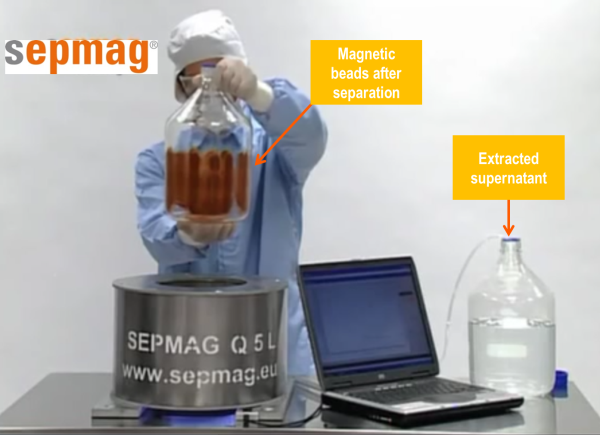When using a standard magnetic separation rack, often you will experience a decrease in bead and biomolecule yield when scaling up your production process. This causes the scaled up process to be less economically efficient than it could be with yields commensurate to your original production.

This post is about biomagnetic separation with a magnetic separation rack, and how to scale-up this process. If you are interested in this topic, download our free ebook The Basic Guide to Scale-up Biomagnetic Separation Processes:
Why does yield decrease when scaling up?
Decreased yield during scaling up in non-homogeneous systems is largely due to the fact that the magnetic force varies with the distance of the bead to the magnet. The force that most distant beads feel is very low and increases quickly as you reach the retention area, close to the magnet. Lower forces cause beads to move slower.
A combination of slower bead movement and longer distances for the beads to travel when using scaled-up volumes, results in very long separation times. If you choose to pump the supernatant out before these long separations are completed, you will subsequently have large losses of magnetic beads along with losses of the expensive biomolecules attached to them.
What solutions do we have available?
One option is to increase the size and weight of the magnetic separation device. This helps you gain increased magnetic force over the farthest beads, but doing so will also have a deleterious effect on the beads already in the retention area. When these beads are exposed to high forces over long periods of time, irreversible aggregation becomes a very serious issue. Aggregation causes the beads to form clumps that are tightly associated with each other. In a best case scenario, the clumps can be disaggregated without damaging the functional biomolecule, but at the cost of time, resources and personnel. You would need to subject the beads to added sonication method steps along with several extra quality control checks in order to monitor the resuspension process.
By far, the best way to avoid all of these potential difficulties during magnetic separation is to generate a high force at distance from the magnet without increasing the force in the retention area. Homogeneous magnetic separation systems such as SEPMAG can accomplish this task. In systems such as SEPMAG, we choose the optimal magnetic force and you will not generate irreversibly aggregated clumps. In addition, since the magnetic force is constant across the entire volume of the vessel, separation times are shorter and material losses are minimal.
Don't forget to check these posts from our blog in order to get a deeper insight into the scaling-up of biomagnetic separation processes:
- How to deal with the 4 typical magnetic separation beads scale up problems?
- How to avoid In-lot inconsistency when scaling up biomagnetic separation processes
- Keeping lot to lot consistency when using biomagnetic separation at different volumes
Check www.sepmag.eu/ebooks to access to FREE eBooks on the subject, or contact us. We will be glad to help you to achieve an efficient magnetic bead separation process!





